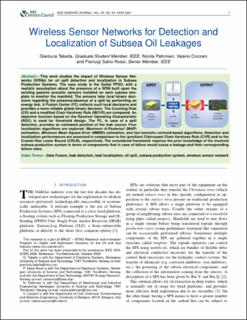Wireless Sensor Networks for Detection and Localization of Subsea Oil Leakages
Journal article, Peer reviewed
Accepted version

Åpne
Permanent lenke
https://hdl.handle.net/11250/2735785Utgivelsesdato
2021Metadata
Vis full innførselSamlinger
Originalversjon
10.1109/JSEN.2021.3060292Sammendrag
This work studies the impact of Wireless Sensor Networks (WSNs) for oil spill detection and localization in Subsea Production Systems. The case study is the Goliat FPSO, with a realistic assumption about the presence of a WSN built upon the existing passive acoustic sensors installed on each subsea template to monitor the manifold. The sensors take local binary decisions regarding the presence/absence of a spill by performing an energy test. A Fusion Center (FC) collects such local decisions and provides a more reliable global binary decision. The Counting Rule (CR) and a modified Chair-Varshney Rule (MCVR) are compared. An objective function based on the Receiver Operating Characteristic (ROC) is used for threshold design. The FC, in case of a spill detection, provides an estimated position of the leak source. Four localization algorithms are explored: Maximum A-Posteriori (MAP) estimation, Minimum Mean Square Error (MMSE) estimation, and two heuristic centroid-based algorithms. Detection and localization performances are assessed in comparison to the (position) Clairvoyant Chair-Varshney Rule (CVR) and to the Cramér-Rao Lower Bound (CRLB), respectively. The considered framework requires the prior knowledge of the involved subsea production system in terms